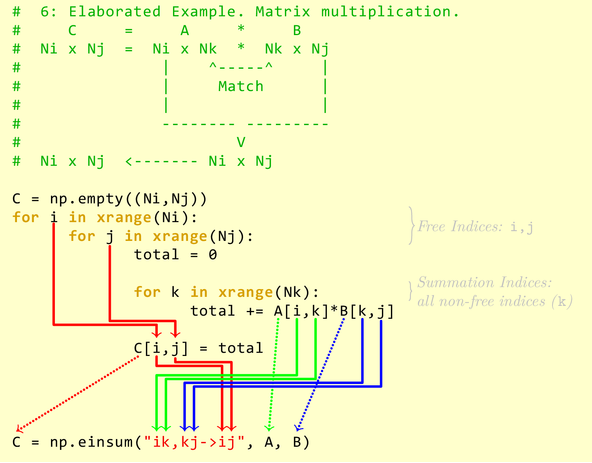Einstein Summation Convention
The Einstein summation convention, introduced by Albert Einstein, is a notational convention that represents summation over a set of indexed term in a formula, achieving notational brevity. With Einstein summation convention, many common linear algebraic operations on multi-dimensional arrays can be represented in a simple fashion.
einsum
numpy.einsum implements the evaluation of Einstein summation convention. The subscripts
string is a common-separated list of subscript labels, where each label refers to a
dimension of the corresponding operand. When a label is repeated, it is summed. The
rules of numpy.einsum can be summarized as1:
- Repeating subscript between input arrays means that values along those axes will be multiplied. The products make up the values for the output array.
- Omitting a latter from the output means values along that axis will be summed.
- We can return the unsummed axes in any order (specified by the output subscripts).
In implicit mode (without output subscript labels), the axes of output are reordered
alphabetically according to the chosen subscripts. In explicit mode (with output
subscript labels), the output can be directly controlled by specifying output subscript
labels. For example, in implicit mode, ij,jk returns the matrix multiplication of
input operands, however ij,jh returns the transpose of matrix multiplication, because
h precedes i in alphabet. In explicit mode, the output axes order can be directly
specified as ij,jh->ih.
>>> a = np.array(range(0, 4)).reshape(2, 2)
>>> b = np.array(range(0, 6)).reshape(2, 3)
>>> np.einsum("ij,jk", a, b)
array([[ 3, 4, 5],
[ 9, 14, 19]])
>>> np.einsum("ij,jh", a, b)
array([[ 3, 9],
[ 4, 14],
[ 5, 19]])
>>> np.einsum("ij,jh->ih", a, b)
array([[ 3, 4, 5],
[ 9, 14, 19]])
All indices in an Einstein summation can be partitioned into two sets:
- free indices: used in the output specification, associated with the outer
for-loop. - summation indices: used to compute and sum over the product terms, associated with the
inner
for-loop.
The basic idea can be elaborated with the following example2:

The numpy-style broadcasting is supported by using ..., or Ellipsis. For example,
i...imeans take the trace along the first and last dimensions....ii->...imeans take the diagonal of the last two dimensions.ij...,jk...->ik...returns a matrix multiplication with the left-most indices instead of the right-most indices.
When there is only one operand, no axes are summed, and no output parameter is provided, a view into operand is returned, instead of returning a new array. When the input array is mutable (writable), the result view is also mutable (writable). For example,
>>> a = np.array(range(9)).reshape(3, 3)
>>> np.einsum("ii->i", a)[:] = -1
>>> a
array([[-1, 1, 2],
[ 3, -1, 5],
[ 6, 7, -1]])
The einsum can be used to implemented many common linear algebraic operators on
multi-dimensional arrays34:
-
np.trace:iiorii->The
iis repeated, thus will be summed. -
np.diag:ii->iThe
iis repeated, but also occurs in output, thus won’t be summed. -
np.sum(axis=1):ij->iThe
iis repeated (in input and output) andjisn’t, thus theiaxes will be summed. -
np.sum(axis=k):...j...->...Sum over a single index for high-dimensional arrays.
-
np.transpose:jiorij->ji -
np.inner:i,i -
Matrix-vector multiplication:
ij,j -
Matrix-matrix multiplication:
ij,jkorij,jk->ik -
Vector outer product:
i,j
einsum_path
numpy.einsum_path evaluates the lowest cost contraction order for a given Einstein
summation notation, by considering the creation of intermediate arrays. The result of
einsum_path is the order of input contraction, and can be used by einsum repeatedly
later to evaluate the expression, without computing the optimization plan repeatedly.
>>> a = np.ones(64).reshape(2, 4, 8)
>>> path = np.einsum_path('ijk,ilm,njm,nlk,abc->', a, a, a, a, a, optimize='optimal')
>>> print(path[0])
['einsum_path', (0, 3), (0, 1), (1, 2), (0, 1)]
>>> print(path[1])
Complete contraction: ijk,ilm,njm,nlk,abc->
Naive scaling: 9
Optimized scaling: 5
Naive FLOP count: 1.311e+06
Optimized FLOP count: 2.305e+03
Theoretical speedup: 568.642
Largest intermediate: 6.400e+01 elements
--------------------------------------------------------------------------
scaling current remaining
--------------------------------------------------------------------------
5 nlk,ijk->injl ilm,njm,abc,injl->
5 njm,ilm->injl abc,injl,injl->
4 injl,injl-> abc,->
3 ,abc-> ->
>>> np.einsum('ijk,ilm,njm,nlk,abc->', a, a, a, a, a, optimize=path[0])
262144.0